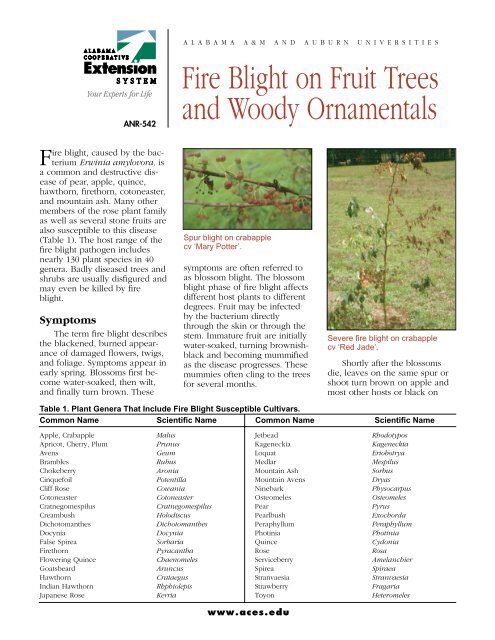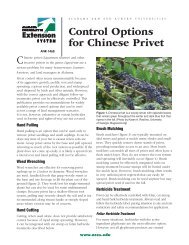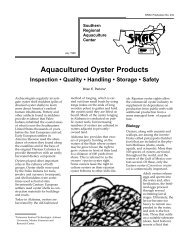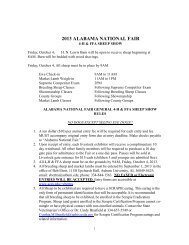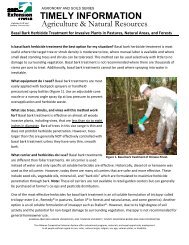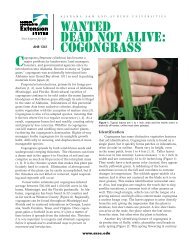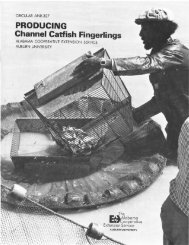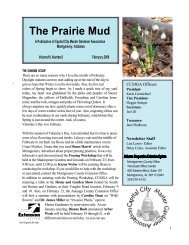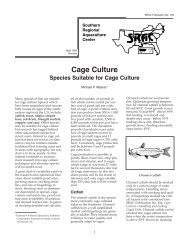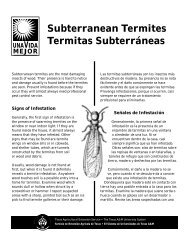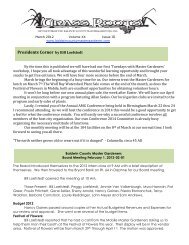Fire Blight on Fruit Trees and Woody Ornamentals - Alabama ...
Fire Blight on Fruit Trees and Woody Ornamentals - Alabama ...
Fire Blight on Fruit Trees and Woody Ornamentals - Alabama ...
You also want an ePaper? Increase the reach of your titles
YUMPU automatically turns print PDFs into web optimized ePapers that Google loves.
ANR-542<br />
<str<strong>on</strong>g>Fire</str<strong>on</strong>g> blight, caused by the bacterium<br />
Erwinia amylovora, is<br />
a comm<strong>on</strong> <strong>and</strong> destructive disease<br />
of pear, apple, quince,<br />
hawthorn, firethorn, cot<strong>on</strong>easter,<br />
<strong>and</strong> mountain ash. Many other<br />
members of the rose plant family<br />
as well as several st<strong>on</strong>e fruits are<br />
also susceptible to this disease<br />
(Table 1). The host range of the<br />
fire blight pathogen includes<br />
nearly 130 plant species in 40<br />
genera. Badly diseased trees <strong>and</strong><br />
shrubs are usually disfigured <strong>and</strong><br />
may even be killed by fire<br />
blight.<br />
Symptoms<br />
The term fire blight describes<br />
the blackened, burned appearance<br />
of damaged flowers, twigs,<br />
<strong>and</strong> foliage. Symptoms appear in<br />
early spring. Blossoms first become<br />
water-soaked, then wilt,<br />
<strong>and</strong> finally turn brown. These<br />
Apple, Crabapple Malus<br />
Apricot, Cherry, Plum Prunus<br />
Avens Geum<br />
Brambles Rubus<br />
Chokeberry Ar<strong>on</strong>ia<br />
Cinquefoil Potentilla<br />
Cliff Rose Cowania<br />
Cot<strong>on</strong>easter Cot<strong>on</strong>easter<br />
Cratnegomespilus Cratnegomespilus<br />
Creambush Holodiscus<br />
Dichotomanthes Dichotomanthes<br />
Docynia Docynia<br />
False Spirea Sorbaria<br />
<str<strong>on</strong>g>Fire</str<strong>on</strong>g>thorn Pyracantha<br />
Flowering Quince Chaenomeles<br />
Goatsbeard Aruncus<br />
Hawthorn Crataegus<br />
Indian Hawthorn Rhphiolepis<br />
Japanese Rose Kerria<br />
A L A B A M A A & M A N D A U B U R N U N I V E R S I T I E S<br />
<str<strong>on</strong>g>Fire</str<strong>on</strong>g> <str<strong>on</strong>g>Blight</str<strong>on</strong>g> <strong>on</strong> <strong>Fruit</strong> <strong>Trees</strong><br />
<strong>and</strong> <strong>Woody</strong> <strong>Ornamentals</strong><br />
Spur blight <strong>on</strong> crabapple<br />
cv ‘Mary Potter’.<br />
symptoms are often referred to<br />
as blossom blight. The blossom<br />
blight phase of fire blight affects<br />
different host plants to different<br />
degrees. <strong>Fruit</strong> may be infected<br />
by the bacterium directly<br />
through the skin or through the<br />
stem. Immature fruit are initially<br />
water-soaked, turning brownishblack<br />
<strong>and</strong> becoming mummified<br />
as the disease progresses. These<br />
mummies often cling to the trees<br />
for several m<strong>on</strong>ths.<br />
Severe fire blight <strong>on</strong> crabapple<br />
cv ‘Red Jade’.<br />
Shortly after the blossoms<br />
die, leaves <strong>on</strong> the same spur or<br />
shoot turn brown <strong>on</strong> apple <strong>and</strong><br />
most other hosts or black <strong>on</strong><br />
Table 1. Plant Genera That Include <str<strong>on</strong>g>Fire</str<strong>on</strong>g> <str<strong>on</strong>g>Blight</str<strong>on</strong>g> Susceptible Cultivars.<br />
Comm<strong>on</strong> Name Scientific Name Comm<strong>on</strong> Name Scientific Name<br />
www.aces.edu<br />
Jetbead Rhodotypos<br />
Kageneckia Kageneckia<br />
Loquat Eriobotrya<br />
Medlar Mespilus<br />
Mountain Ash Sorbus<br />
Mountain Avens Dryas<br />
Ninebark Physocarpus<br />
Osteomeles Osteomeles<br />
Pear Pyrus<br />
Pearlbush Exochorda<br />
Peraphyllum Peraphyllum<br />
Photinia Photinia<br />
Quince Cyd<strong>on</strong>ia<br />
Rose Rosa<br />
Serviceberry Amelanchier<br />
Spirea Spiraea<br />
Stranvaesia Stranvaesia<br />
Strawberry Fragaria<br />
Toy<strong>on</strong> Heteromeles
pear. The stems <strong>and</strong> midribs of<br />
diseased leaves often turn black<br />
as well. As the twig <strong>and</strong> leaf<br />
blight phase progresses, leaves<br />
die, curl downward, <strong>and</strong> cling to<br />
the blighted twigs. Succulent<br />
twigs, shoots, <strong>and</strong> water sprouts<br />
are easily infected. The tips of<br />
blighted twigs, shoots, <strong>and</strong><br />
sprouts droop, producing the<br />
typical “shepherd’s crook.”<br />
Leaves may be infected through<br />
pores as well as wounds.<br />
Cankers form at the base of<br />
blighted twigs <strong>and</strong> spurs. The<br />
bark surrounding a developing<br />
canker first appears watersoaked,<br />
then later sunken <strong>and</strong><br />
dry. The surface of bark covering<br />
the canker is usually smooth<br />
<strong>and</strong> sometimes has a purple<br />
color. Reddish-brown streaks can<br />
be seen in the sapwood under<br />
the discolored, sunken bark.<br />
Amber-colored discharge can<br />
often be seen near blighted tissues<br />
of the plant at any stage of<br />
infecti<strong>on</strong>.<br />
Characteristics<br />
The fire blight pathogen,<br />
Erwinia amylovora, is a rodshaped<br />
bacterium that overwinters<br />
in tissues around the edge of<br />
cankers <strong>on</strong> large branches <strong>and</strong><br />
limbs. A gummy, amber-colored<br />
discharge oozes from cankers during<br />
warm, humid weather. The<br />
discharge, which c<strong>on</strong>tains bacteria,<br />
is dispersed by insects or<br />
splashing rain to blossoms, leaves,<br />
<strong>and</strong> shoots (see drawing <strong>on</strong> next<br />
page). Dried bacterial discharge<br />
often forms str<strong>and</strong>s which are carried<br />
by wind.<br />
Susceptibility to fire blight<br />
depends <strong>on</strong>: (1) cultivar characteristics,<br />
(2) maturity of tissue,<br />
<strong>and</strong> (3) weather c<strong>on</strong>diti<strong>on</strong>s. Pear<br />
flowers are invaded very rapidly<br />
through nectaries <strong>and</strong> pistils,<br />
which are ideal sites for growth<br />
of the bacteria. Apple flowers<br />
are usually invaded through stigmas<br />
<strong>and</strong> anthers.<br />
Soft, succulent shoots are very<br />
vulnerable to the disease. Mature<br />
apple <strong>and</strong> pear tissues are much<br />
more resistant to infecti<strong>on</strong> than<br />
young tissues. Cultural practices<br />
favoring rapid shoot growth increase<br />
the plants’ susceptibility to<br />
attack. These practices include severe<br />
pruning, excessive nitrogen<br />
fertilizati<strong>on</strong>, <strong>and</strong> an unbalanced<br />
fertility program.<br />
Warm, moist c<strong>on</strong>diti<strong>on</strong>s, particularly<br />
during flowering, greatly<br />
increase incidence of the disease.<br />
<str<strong>on</strong>g>Blight</str<strong>on</strong>g> development can occur at<br />
temperatures between 65° <strong>and</strong><br />
95°F, but the 75° to 81°F range is<br />
most favorable. Temperature extremes<br />
will slow development of<br />
the disease. In regi<strong>on</strong>s with mild<br />
winter temperatures, cankers may<br />
increase in size during the fall<br />
<strong>and</strong> winter <strong>on</strong> trees with a southerly<br />
exposure. Rain is critical to<br />
the spread <strong>and</strong> development of<br />
the disease. <str<strong>on</strong>g>Fire</str<strong>on</strong>g> blight outbreaks<br />
are encouraged by warm, cloudy<br />
weather following a rain. A<br />
humid envir<strong>on</strong>ment promotes<br />
bacterial growth <strong>and</strong> spread.<br />
Other weather events like frost,<br />
high winds, <strong>and</strong> hail create<br />
wounds through which the bacteria<br />
can enter the plant.<br />
Typical ‘Shepherds Crook’ often<br />
seen at the end of fire blightdamaged<br />
shoots. The brown color<br />
of the blighted leaves indicates that<br />
this blighted shoot is <strong>on</strong> apple or<br />
crabapple.<br />
2<br />
C<strong>on</strong>trol<br />
A c<strong>on</strong>trol program combining<br />
resistant varieties, sound cultural<br />
practices, sanitati<strong>on</strong>, fertilizati<strong>on</strong>,<br />
<strong>and</strong> pesticides is needed to protect<br />
plants from fire blight. Cultivati<strong>on</strong><br />
<strong>and</strong> fertilizati<strong>on</strong> practices<br />
that produce rank, succulent<br />
growth increase the possibility<br />
that the disease will develop. Do<br />
not cultivate pear <strong>and</strong> apple orchards<br />
late in the seas<strong>on</strong>, <strong>and</strong> do<br />
not severely prune susceptible<br />
cultivars. Regulate plant growth<br />
<strong>and</strong> apply fertilizers so that moderate<br />
shoot growth is maintained.<br />
Beginning in late winter to early<br />
spring <strong>and</strong> c<strong>on</strong>tinuing through the<br />
growing seas<strong>on</strong>, remove all root<br />
sprouts <strong>and</strong> suckers from trees.<br />
All diseased tissue (blighted twigs<br />
<strong>and</strong> branches) should be removed<br />
as so<strong>on</strong> as possible to<br />
slow the spread of the disease.<br />
Prune diseased wood about 12 to<br />
14 inches below visible cankers<br />
during the growing seas<strong>on</strong>, <strong>and</strong> 6<br />
to 8 inches below cankers in the<br />
fall or winter m<strong>on</strong>ths. Clean your<br />
tools with a soluti<strong>on</strong> of isopropyl<br />
alcohol or other disinfectant after<br />
each cut to avoid spreading the<br />
bacteria.<br />
The first chemicals used for<br />
the c<strong>on</strong>trol of fire blight were<br />
copper fungicides like copper hydroxide<br />
(Kocide 101 at 2 to 4<br />
pounds per 100 gall<strong>on</strong>s of water<br />
between silver-tip <strong>and</strong> green tip<br />
<strong>on</strong> apple <strong>and</strong> pear) <strong>and</strong> copper<br />
sulfate (Tri-Basic Copper Sulfate<br />
at 1 ⁄2 pound per 100 gall<strong>on</strong>s of<br />
water <strong>on</strong> pear <strong>on</strong>ly). Recommended<br />
spray schedules are listed <strong>on</strong><br />
the product labels. These compounds<br />
provide effective c<strong>on</strong>trol<br />
under light to moderate disease<br />
pressure but can cause fruit russeting<br />
<strong>on</strong> some apple <strong>and</strong> pear<br />
varieties. Copper fungicides that<br />
are cleared for fire blight c<strong>on</strong>trol<br />
<strong>on</strong> woody ornamentals may be<br />
phytotoxic to crabapple <strong>and</strong><br />
some other plants.<br />
Copper hydroxide (Kocide<br />
2000 T/N/O at 0.75 pounds per<br />
100 gall<strong>on</strong>s of water or 1.5
Disease Cycle of <str<strong>on</strong>g>Fire</str<strong>on</strong>g> <str<strong>on</strong>g>Blight</str<strong>on</strong>g><br />
Bees carry bacteria<br />
to blossoms<br />
Insects pick up ooze<br />
from edge of holdover<br />
canker<br />
Bacterial cells<br />
teaspo<strong>on</strong>s per gall<strong>on</strong>) <strong>and</strong> copper<br />
sulfate pentahydrate (Phyt<strong>on</strong><br />
27 at 20 to 40 fluid ounces per<br />
100 gall<strong>on</strong>s of water) will give<br />
some protecati<strong>on</strong> from fire blight<br />
<strong>on</strong> woody ornamentals. See the<br />
comments for streptomycin sulfate<br />
for instructi<strong>on</strong>s <strong>on</strong> optimum<br />
applicati<strong>on</strong> timing for the c<strong>on</strong>trol<br />
of fire blight. Kocide 2000 will<br />
damage the foliage of crabapple<br />
but is safe to use <strong>on</strong> Indian<br />
hawthorn, loquat, hawthorn,<br />
photinia, pyracantha, <strong>and</strong> flowering<br />
pear. Refer to the label of<br />
each fungicide for additi<strong>on</strong>al<br />
directi<strong>on</strong>s <strong>on</strong> product use.<br />
The antibiotic streptomycin<br />
(Agrimycin 17) will give better<br />
c<strong>on</strong>trol under higher disease<br />
pressure than the copper compounds,<br />
<strong>and</strong> does not cause fruit<br />
russeting. When using these<br />
products, start spraying as so<strong>on</strong><br />
as bloom begins because streptomycin<br />
is ineffective against fire<br />
blight <strong>on</strong>ce infecti<strong>on</strong> occurs.<br />
Protective sprays of Agrimycin<br />
17 at 100 ppm (8 ounces of formulated<br />
product per 100 gall<strong>on</strong>s<br />
of water or 1 tablespo<strong>on</strong> per 2 1 ⁄2<br />
gall<strong>on</strong>s of water) or <str<strong>on</strong>g>Fire</str<strong>on</strong>g>blight<br />
Primary<br />
Cycle<br />
Bacteria enter<br />
uncuticularized<br />
flowering parts<br />
Bacteria<br />
splashed<br />
to blossoms<br />
<strong>and</strong> twigs<br />
Bacteria oozing from<br />
infected cortex<br />
The surface of this perennial fire<br />
blight canker <strong>on</strong> the main trunk of<br />
pear is cracked <strong>and</strong> dry. Note the<br />
dead branch stub in the center of<br />
the canker.<br />
3<br />
Sec<strong>on</strong>dary<br />
cycles<br />
Blossom <strong>and</strong><br />
leaf blight<br />
<str<strong>on</strong>g>Blight</str<strong>on</strong>g>ing of<br />
twigs <strong>and</strong><br />
limbs<br />
Canker at base<br />
of diseased<br />
shoot<br />
Spray (0.5 teaspo<strong>on</strong> per gall<strong>on</strong><br />
of water) are recommended<br />
every 4 to 5 days during the<br />
bloom period. Begin spraying<br />
just before the center flower in<br />
the cluster opens <strong>and</strong> c<strong>on</strong>tinue<br />
applicati<strong>on</strong>s through petal fall.<br />
For best results, make applicati<strong>on</strong>s<br />
in the late afterno<strong>on</strong> or<br />
early evening because streptomycin<br />
breaks down in sunlight.<br />
Aphids, leafhoppers, flies,<br />
<strong>and</strong> ants play a major role in<br />
spreading the bacteria from<br />
cankers to blooms <strong>and</strong> new<br />
growth in the spring. These insects<br />
should be m<strong>on</strong>itored <strong>and</strong><br />
c<strong>on</strong>trolled with insecticides if<br />
necessary before bloom occurs.<br />
Bees do not feed <strong>on</strong> bacterial<br />
ooze but will spread the disease<br />
from infected to n<strong>on</strong>infected<br />
blossoms during pollinati<strong>on</strong>.<br />
Insecticides used during bloom<br />
will kill the bees, but pollinati<strong>on</strong><br />
will also be prevented, greatly<br />
reducing fruit set.<br />
Many popular trees <strong>and</strong><br />
shrubs are resistant to fire blight.<br />
Establishment of disease-resistant<br />
plants is an inexpensive, easy,
<strong>and</strong> effective means of c<strong>on</strong>trolling<br />
fire blight without the need<br />
for chemical treatments. Some<br />
shrubs <strong>and</strong> small trees resistant<br />
to fire blight are listed in Table<br />
2. Refer to Table 3 for reacti<strong>on</strong><br />
of some apple <strong>and</strong> pear varieties<br />
to fire blight.<br />
The reacti<strong>on</strong> of selected<br />
crabapple <strong>and</strong> flowering pear<br />
cultivars to fire blight is listed in<br />
Table 4. Crabapple cultivars resistant<br />
to fire blight, as well as<br />
apple scab, powdery mildew,<br />
cedar-apple rust, <strong>and</strong> frog-eye<br />
leaf spot are Adams, C<strong>and</strong>ied<br />
Apple, Centennial, Centuri<strong>on</strong>,<br />
Dolgo, Liset, Sargent, Sugartyme,<br />
<strong>and</strong> Zuni.<br />
Resistant firethorn cultivars<br />
include Pyracantha coccinea cv.<br />
Sensati<strong>on</strong>, P. koidzumii cv. Santa<br />
Cruz Prostrata, <strong>and</strong> hybrids San<br />
Jose <strong>and</strong> Shawnee. The firethorn<br />
cultivars Apache, <str<strong>on</strong>g>Fire</str<strong>on</strong>g> Cascade,<br />
Mohane, Navaho, Pueblo,<br />
Rutgers, Shawnee, <strong>and</strong> Tit<strong>on</strong> are<br />
resistant to both fire blight <strong>and</strong><br />
scab. Cot<strong>on</strong>easter selecti<strong>on</strong>s resistant<br />
to fire blight include C.<br />
apiculatus, C. dialsianus, C.<br />
foveolatus, C. franchetti, C. integerrimus,<br />
C. nitens, <strong>and</strong> C.<br />
zabelli. Severe outbreaks of fire<br />
blight have been noted <strong>on</strong><br />
Cot<strong>on</strong>easter dammeri in both<br />
producti<strong>on</strong> nurseries <strong>and</strong> l<strong>and</strong>scape<br />
plantings.<br />
Table 2. <str<strong>on</strong>g>Fire</str<strong>on</strong>g> <str<strong>on</strong>g>Blight</str<strong>on</strong>g> Resistant Members of the Rose Family.<br />
Scientific Name Comm<strong>on</strong> Name<br />
Cercocarpus betuloides Mountain-mahogamy<br />
Exochorda racemosa comm<strong>on</strong> pearl bush<br />
Fragaria chiloensis beach strawberry<br />
Photinia serrulata Chinese photinia<br />
Physocarpus capitatus ninebark<br />
Potentilla fruiticosa bush cinquefoil<br />
Prunus americana American plum<br />
Prunus cerasus sour cherry<br />
Prunus dulces alm<strong>on</strong>d<br />
Prunus hortulana wild-goose plum<br />
Prunus mahaleb St. Lucie cherry<br />
Rosa californica California wild rose<br />
Rosa gymnocarpa wood rose<br />
Spirea prunifolia bridal wreath<br />
4<br />
Note the reddish-brown discolorati<strong>on</strong><br />
of the bark covering this fire<br />
blight canker.<br />
Am<strong>on</strong>g Indian hawthorn selecti<strong>on</strong>s,<br />
‘Jack Evans’ <strong>and</strong> ‘Janice’ are<br />
highly sensitive to fire blight. Also,<br />
significant fire blight damage has<br />
been seen <strong>on</strong> the cultivars ‘Olivia’<br />
<strong>and</strong> ‘Majestic Beauty’. Most other<br />
Indian hawthorn selecti<strong>on</strong>s, including<br />
‘Clara’, ‘Elenor’, ‘Tabor’, ‘Indian<br />
Princess’, <strong>and</strong> ‘Snow’ are highly<br />
resistant to fire blight <strong>and</strong> typically<br />
suffer very little damage in l<strong>and</strong>scape<br />
plantings.
Table 3. Reacti<strong>on</strong> of Various Apple <strong>and</strong> Pear Varieties to <str<strong>on</strong>g>Fire</str<strong>on</strong>g> <str<strong>on</strong>g>Blight</str<strong>on</strong>g>.*<br />
Moderately Moderately Highly<br />
Resistant Susceptible Susceptible<br />
Apple Empire Freedom Golden Delicious<br />
Liberty Golden Delicious Granny Smith<br />
Priscilla J<strong>on</strong>afree J<strong>on</strong>athan<br />
Redspur McIntosh Julyred<br />
Red Delicious Prima Lodi<br />
Topred Redfree Mutsu<br />
Yates Stayman Paulared<br />
Arkansas Black Turley Rome<br />
Winesap Transparent<br />
J<strong>on</strong>agold Tydman’s Red<br />
Fuji<br />
Brayburn<br />
Gayla<br />
Mollies Delicious<br />
Pear Ayers Seckel Bartlett<br />
Keiffer Bosc<br />
Mo<strong>on</strong>glow<br />
Orient<br />
Red Bartlett<br />
*This is <strong>on</strong>ly a partial list of comm<strong>on</strong> varieties. Actual reacti<strong>on</strong>s may differ depending <strong>on</strong> envir<strong>on</strong>mental c<strong>on</strong>diti<strong>on</strong>s. C<strong>on</strong>tact your<br />
local county agent for informati<strong>on</strong> <strong>on</strong> overall quality of a variety before planting.<br />
Table 4. Reacti<strong>on</strong> of Crabapple <strong>and</strong> Flowering Pear Cultivars to <str<strong>on</strong>g>Fire</str<strong>on</strong>g> <str<strong>on</strong>g>Blight</str<strong>on</strong>g>.<br />
Resistant- Slightly to<br />
Moderately Moderately Highly<br />
Resistant Susceptible Susceptible<br />
Crabapple M. Baccata ‘Jackii’ Red Jewel Klehm’s Imperial Bechtel<br />
Coral Burst Red Bar<strong>on</strong> Golden Raindrops<br />
Pink Princess Tea Doubleblooms<br />
Spring Snow Royalty Snowdrift<br />
Jewelberry Hopa Silver Mo<strong>on</strong><br />
Robins<strong>on</strong> Dwarf Br<strong>and</strong>ywine Professor Sprenger<br />
Adams Dwarf Winter Gold Indian Magic<br />
Radient C<strong>and</strong>ied Apple Siami <str<strong>on</strong>g>Fire</str<strong>on</strong>g><br />
Velvet Pillar Selbirk Sentinel<br />
Pink Spires Sugar Tyme Purple Prince<br />
Liset (Dwarf) Ormist<strong>on</strong> Roy Mary Potter<br />
Profusi<strong>on</strong><br />
Bob White<br />
David<br />
Indian Summer<br />
Sargentii (Dwarf)<br />
Zumi var. Calocarpa<br />
Eleya<br />
White Angel<br />
Red Splendor<br />
Louisa<br />
Baskat<strong>on</strong>g<br />
Centuri<strong>on</strong><br />
Prariefire<br />
D<strong>on</strong>ald Wyman<br />
Strawberry Parfait<br />
Red Jade<br />
Flowering Pear Bradford Capital Aristocrat<br />
Clevel<strong>and</strong> Select Autumn Blaze<br />
Earlyred Fauriei<br />
Whitehouse Redspire<br />
5
ANR-542<br />
Austin Hagan, Extensi<strong>on</strong> Plant Pathologist, Professor, <strong>and</strong> Edward Sikora, Extensi<strong>on</strong> Plant<br />
Pathologist, Professor, both in Entomology <strong>and</strong> Plant Pathology at Auburn University, <strong>and</strong><br />
William Gazaway, former Extensi<strong>on</strong> Plant Pathologist. Originally prepared by Nancy Kokalis-<br />
Burelle, former Graduate Assistant, Plant Pathology, Auburn University.<br />
Trade names are used <strong>on</strong>ly to give specific informati<strong>on</strong>. The <strong>Alabama</strong> Cooperative Extensi<strong>on</strong><br />
System does not endorse or guarantee any product <strong>and</strong> does not recommend <strong>on</strong>e product<br />
instead of another that might be similar.<br />
For more informati<strong>on</strong>, call your county Extensi<strong>on</strong> office. Look in your teleph<strong>on</strong>e directory<br />
under your county’s name to find the number.<br />
Issued in furtherance of Cooperative Extensi<strong>on</strong> work in agriculture <strong>and</strong> home ec<strong>on</strong>omics, Acts of May 8 <strong>and</strong> June<br />
30, 1914, <strong>and</strong> other related acts, in cooperati<strong>on</strong> with the U.S. Department of Agriculture. The <strong>Alabama</strong><br />
Cooperative Extensi<strong>on</strong> System (<strong>Alabama</strong> A&M University <strong>and</strong> Auburn University) offers educati<strong>on</strong>al programs,<br />
materials, <strong>and</strong> equal opportunity employment to all people without regard to race, color, nati<strong>on</strong>al origin, religi<strong>on</strong>,<br />
sex, age, veteran status, or disability. 7M, Revised July 2004, ANR-542


